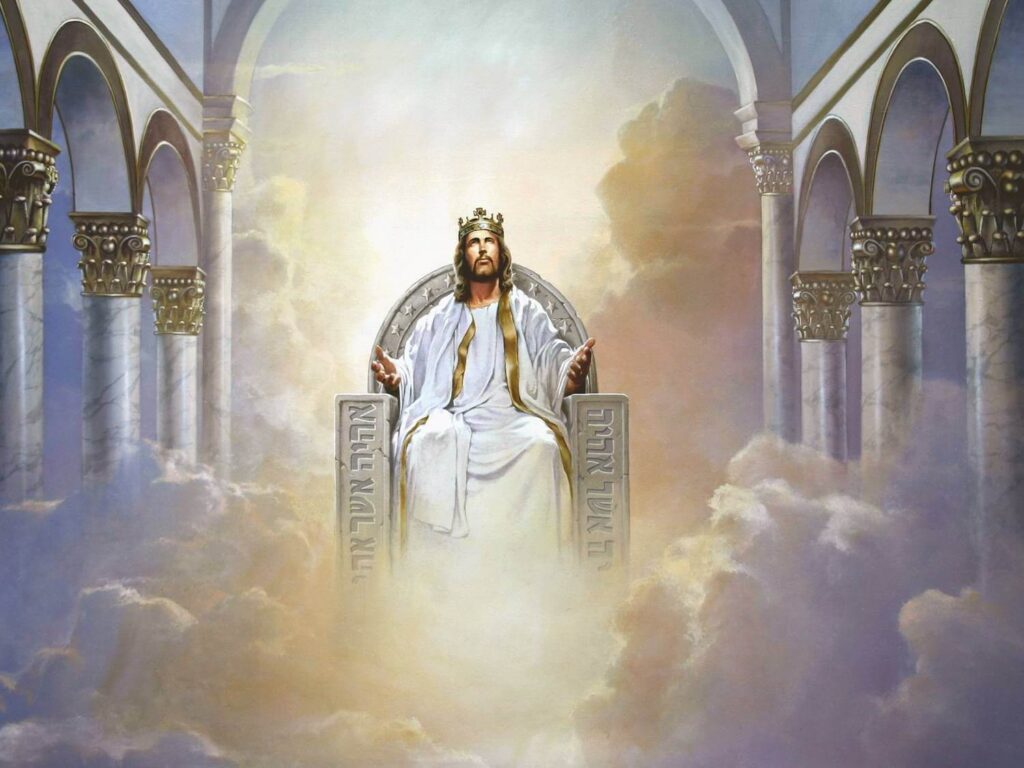
The Eighth Day of the Feast
What Does This “Superabundant” Day Mean for Us?
Of all of the Feast days mentioned in the Bible, there is one for which there is very little said. Because of this we know little of its meanings and implications for us, unlike we do for the other six Feasts of the Lord. These seven Feasts, as elucidated in Leviticus 23 and elsewhere, are listed below, along with a brief meaning of the days.
Nisan 14. Passover => Christ crucified to abolish the sins of those whom He calls
Nisan 15 to 21. Days of Unleavened Bread (Feast of Firstfruits) => Harvest of the firstfruits (barley) — Israel
Sivan ?. Pentecost (Feast of Weeks) => Harvest of the greater portion of mankind (wheat) — Gentiles
Tishri 1. Feast of Trumpets => Return of Jesus Christ and the resurrection of the firstfruits
Tishri 10. Day of Atonement => The saints enter the presence of the heavenly temple for the marriage supper
Tishri 15 to 21. Feast of Tabernacles => Millennial reign of Jesus Christ and the saints
Tishri 22. Last Great Day => Second Resurrection and the next phase of God’s plan
A timeline of these Feast days is shown on the next page, along with their meanings, from Passover to the Last Great Day. The history of God’s plan for the redemption of mankind through the nation of Israel is summarized: Israel is captive in Egypt, then escapes through the Red Sea crossing (Passover and Days of Unleavened Bread), journeys to Mt. Sinai to receive the Law (Pentecost), wanders in the wilderness for 40 years before crossing the Jordan River into Canaan (Feast of Trumpets and Day of Atonement), lives in the Promised Land of Canaan (Feast of Tabernacles), and experiences another age after the millennium (Last Great Day). These days have a direct parallel with the life experience of the elect, who are called by the Father and repent of their sins (Passover and the Days of Unleavened Bread), are baptized (Pentecost), wander in this world while overcoming sin until they attain the resurrection (Feast of Trumpets), meet the Father and Christ at the heavenly throne before returning to earth to defeat the Beast power (Day of Atonement), live as kings and priests on earth for 1,000 years (Feast of Tabernacles), and prosper into the post-millennial age (Last Great Day). See the following page for a further review of these wonderful days.
The Eighth Day in Scripture
The Last Great Day is not spoken of a lot in Scripture, but we read about it in the following places:
Leviticus 23:34-39. “Speak to the children of Israel, saying: ‘The fifteenth day of this seventh month shall be the Feast of Tabernacles for seven days to the Lord. On the first day there shall be a holy convocation. You shall do no customary work on it. For seven days you shall offer an offering made by fire to the Lord. On the eighth day you shall have a holy convocation, and you shall offer an offering made by fire to the Lord. It is a sacred assembly, and you shall do no customary work on it. These are the feasts of the Lord which you shall proclaim to be holy convocations, to offer an offering made by fire to the Lord, a burnt offering and a grain offering, a sacrifice and drink offerings, everything on its day — besides the Sabbaths of the Lord, besides your gifts, besides all your vows, and besides all your freewill offerings which you give to the Lord. Also on the fifteenth day of the seventh month, when you have gathered in the fruit of the land, you shall keep the feast of the Lord for seven days; on the first day there shall be a Sabbath-rest, and on the eight day a Sabbath-rest.’”
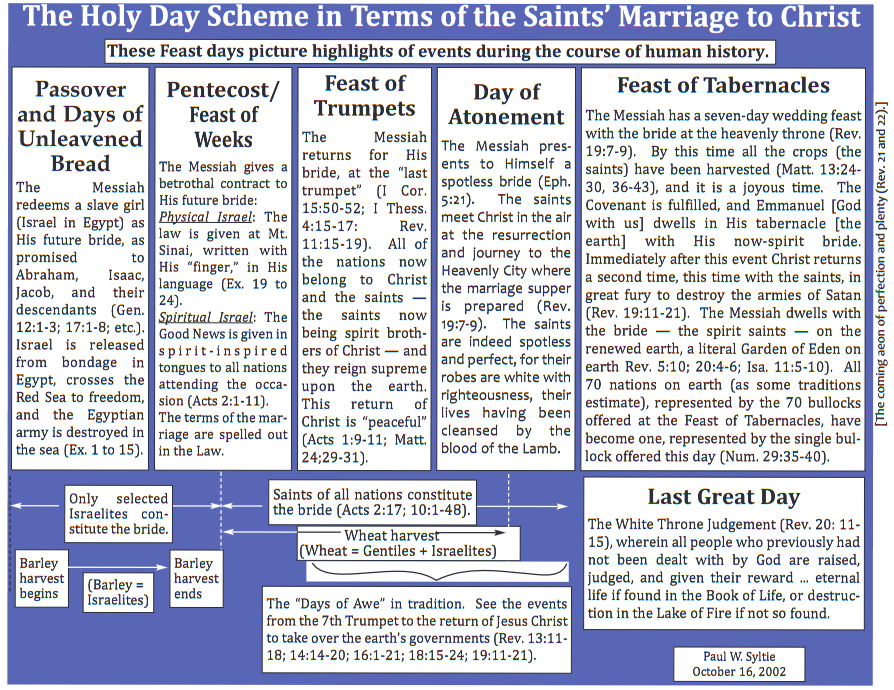
Nehemiah 8:18. “Also day by day, from the first day until the last day, he read from the Book of the Law of God. And they kept the feast seven days; and on the eighth day there was a sacred assembly, according to the prescribed manner.”
Numbers 29:35. “On the eighth day you shall have a sacred assembly. You shall do no customary work.”
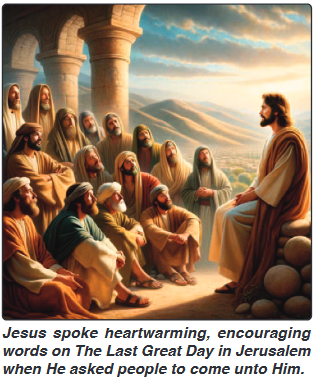 II Chronicles 7:8-10. “At that time Solomon kept the feast seven days, and all Israel with him, a very great assembly from the entrance of Hamath to the Brook of Egypt. And on the eighth day they held a sacred assembly, for they observed the dedication of the altar seven days, and the feast seven days. On the twenty-third day of the seventh month he sent the people away to their tents, joyful and glad of heart for the good that the Lord had done for David, for Solomon, and for His people Israel.”
II Chronicles 7:8-10. “At that time Solomon kept the feast seven days, and all Israel with him, a very great assembly from the entrance of Hamath to the Brook of Egypt. And on the eighth day they held a sacred assembly, for they observed the dedication of the altar seven days, and the feast seven days. On the twenty-third day of the seventh month he sent the people away to their tents, joyful and glad of heart for the good that the Lord had done for David, for Solomon, and for His people Israel.”
John 7:37-39. “On the last day, that great day of the feast, Jesus stood and cried out saying, ‘If anyone thrist, let him come to Me and drink. He who believes in Me, as the Scripture has said, out of his heart will flow rivers of living water.’ But this He spoke concerning the Spirit, whom those believing in Him would receive; for the holy spirit was not yet given, because Jesus was not yet glorified.”
The Character of the Day
Four unique qualities of the Last Great Day stand out:
1. On this eighth day there were more sacrifices offered than for any other holy day.
2. The day had special significance because it is explained by Jesus as follows: “He that believes in Me, as the Scripture has said, out of his body shall flow rivers of living water. (But this He spoke of the spirit, which they that believe on Him should receive.)” (John 7:37-38). Those who believe in Him are the elect who have received His spirit, which is defined by the fruits of the spirit in those who have received it: love, joy, peace, patience, kindness, goodness, faithfulness, gentleness, and self-control (Galatians 5:22-23). Those who believe in Him are the elect, who will be doing His will.
3. Therefore, the Last Great Day refers to the activity of the holy spirit of God flowing into and out of God’s elect, not only for those in the first resurrection but for those in the second resurrection as well. The day refers to the spirit flowing through all people … including those raised during the White Throne Judgment of Revelation 20:11-15.
“Then I saw a great white throne and Him who sat on it, from whose face the earth and the heaven fled away. And there was found no place for them. And I saw the dead, small and great, standing before God, and books were opened. And another book was opened, which is the Book of Life. And the dead were judged according to their works, by the things which were written in the books [that is their DNA, or personal traits: Psalm 139:13-16]. The sea gave up the dead who were in it [in the sea, such as those who perished in the Flood], and Death and Hades delivered up the dead who were in them [on the land]. And they were judged each one according to his works. Then Death and Hades were cast into the lake of fire. This is the second death. And anyone not found written in the Book of Life was cast into the lake of fire.”
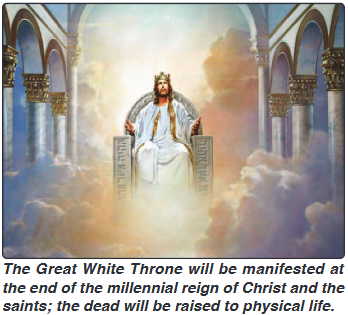 Verse 12 says that “… they were judged each one according to his works,” but we should understand that as not meaning that you can gain salvation by works — for salvation is a gift to us undeserving people (Romans 6:23; Ephesians 2:8) — or that we can improve our position in the government of God in the coming age by doing more good works than someone else. Since the Bible interprets itself we should look a bit further into Revelation, to 22:12, where it says, “And behold, I come quickly, and my reward is with me, to give every man according as his work shall be” (KJV). Some other versions agree with this translation, such as Webster’s Bible Translation, the Literal Standard Version, Young’s Literal Translation, and Smith’s Literal Translation. Our Creator has a definite plan for us reserved in His realm.
Verse 12 says that “… they were judged each one according to his works,” but we should understand that as not meaning that you can gain salvation by works — for salvation is a gift to us undeserving people (Romans 6:23; Ephesians 2:8) — or that we can improve our position in the government of God in the coming age by doing more good works than someone else. Since the Bible interprets itself we should look a bit further into Revelation, to 22:12, where it says, “And behold, I come quickly, and my reward is with me, to give every man according as his work shall be” (KJV). Some other versions agree with this translation, such as Webster’s Bible Translation, the Literal Standard Version, Young’s Literal Translation, and Smith’s Literal Translation. Our Creator has a definite plan for us reserved in His realm.
“In my Father’s house are many mansions [mone, ‘residences, abodes’] and if it were not so I would have told you. I go to prepare [hetoimazo, ‘prepare, make ready’] a place for you. And if I go and prepare a place for you I will come again, and receive you unto myself, that where I am, there you may be also” (John 14:2-3).
We will comprise the heavenly city, the New Jerusalem, and all of us will be the shining gems that decorate that incredibly magnificent place (Revelation 21:2-3! God is no respector of persons (Acts 10:34; Romans 2:11), and He will grant each of us to be kings and priests (Revelation 5:10), sons of God made in His image, just like Him (I John 3:2; Romans 8:29; I Corinthians 15:49; Philippians 3:21; Colossians 3:4; II Peter 1:4).
Just as He has given each of us various gifts of the spirit (I Corinthians 12), exactly as He has willed it, so He will place each of His resurrected elect into the heavenly Kingdom just as He has prepared that place for us. “But now God has set the members every one of them in the body as it has pleased Him” (verse 18). This is not to say that each one of the resurrected elect will have the same responsibilities in the Kingdom.
4. Another quality of the Last Great Day is that it gives a strong message of Godly government that should exist within the ecclesia. We need to understand how this Last Great Day fits into God’s system of government, and by government I mean the interrelationships we have with each other. Government is about relationships, and we need to know the nature of those relationships … and like everything else in our calling avoid the world and cling to what is right and good … be in the world but not of the world (John 15:19; 17:14).
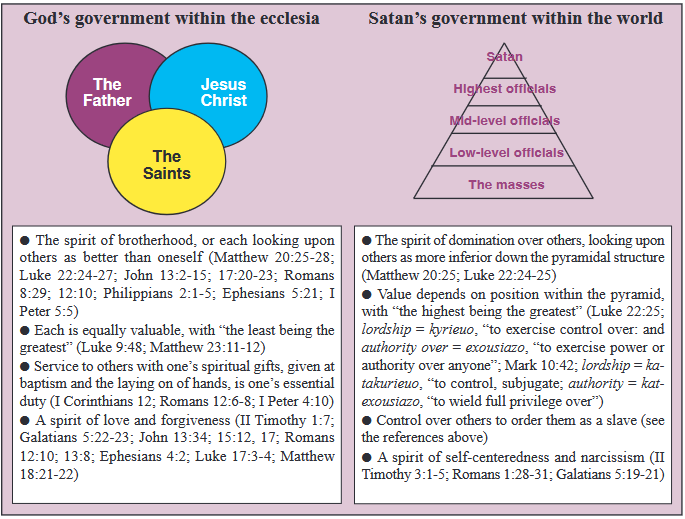
There are two opposing forms of government in the world — God’s and Satan’s — and since we are living in Satan’s world the examples we see around us are those of Satan. What are those characteristics? They come from a system of repressiveness and dictatorship, of hierarchies and control as pictured by a pyramid.
What a stark contrast there is between these forms! Of course, there are gradations from a totalitarian concentration camp to the very heavenly Kingdom of God itself. We see democracy, theocracy, republics, kingships, socialism, and Communism have traits more or less of either extreme. The point we must emphasize is that we are to be striving toward God’s form of Government, as typified in John 17:20-23. We live within the Father and Jesus Christ and each other, in love and perfect fellowship. What a far cry this is from the domination of people over other people in Satan’s system.

The Number 8
Inherent within an understanding of the Last Great Day is the number eight. The day is called the eighth day of the fall Feast of Tabernacles, and this number has wonderfully rich meaning in the context of Bible prophecy. To unfold the number eight as it relates to the Last Great Day I will rely heavily on E.W. Bullinger’s Number in Scripture (Kregel Publications, Grand Rapids, Michigan, 1984, pages 196-204).
“In Hebrew the number eight is הַשְּׁמִינִ֖י (Sh’moneh), from the Hebrew Shah’meyn, ‘to make fat,’ ‘cover with fat,’ ‘to super-abound.’ As a participle it means ‘one who abounds in strength,’ etc. As a noun it is ‘superabundant fertility,’ ‘oil,’ etc. So that as a numeral it is the superabundant number. As seven was so called because the seventh day was the day of completion and rest, so eight, as the eighth day, was over and above this perfect completion, and was indeed the first of a new series, as well as being the eighth. Thus it already represents two numbers in one, the first and eighth. Let us first consider the connection between eight and seven together.”
Seven means that which is spiritually complete or satisfying, while eight denotes what is superabundant or satiating. Examples of the two numbers used together are as follows:
- God’s covenants with Abraham. They were eight in number, seven before Isaac was offered up and the eighth being when he had been received “in a figure” from the dead (Genesis 12;1-3, 7; 13:14-17; 15:13-21; 17:1-22; 18:9-15; 21:12; 22:15-18).
- Joseph’s communication with his brethren. There were seven of them before Jacob’s death and an eighth after he died (Genesis 37:6-10; 43:15-34; 44:14-34; 45:1-24; 46:29-34; 47:1-9; 49:33; 50:7-22.
- The Feast of Tabernacles. Seven days was for the Feast of Tabernacles, and the eighth day was the Great Day (Leviticus 23:39; Numbers 29: 35; Nehemiah 8:18).
- The appeals of Solomon in his prayer. Seven of the appeals were “Hear You from heaven,” and once the appeal was “Hear You from Your dwelling-place, from heaven” (II Chronicles 6: 21-39).
- Steps in Ezekiel’s temple. Seven led into the outer court, and eight led from the outer to the inner court. The seven led from labor to rest, and the eight from rest to worship (Ezekiel 40:22, 26, 31, 34, 37).
- Jesus on the Mount of Olives. He was on the Mount seven times before His crucifixion, and an eighth time after He rose from the dead.
- Abraham’s sons. The sons were eight in total, seven of which were “born after the flesh” and one was born “by promise.”
- The consecration of Aaron and his sons. This consecration took place on the eighth day after abiding at the door of the Tabernacle of the Congregation seven days, day and night (Leviticus 8:35; 9:1).
- Furnishings in the tabernacle and temple. There were seven items in the tabernacle, and eight items in the temple of Solomon.
- Commands to keep the Sabbath holy. Seven commands to keep it holy were voiced by Yahweh, (Exodus 20:8; 31:14, 15; Leviticus 19:3, 30; 23:3; Deuteronomy 5:12;), and one by Moses (Exodus 35:2).
- The sons of Jesse. There were eight sons of Jesse, David being the eight (I Samuel 16:10; 17:12).
The number eight by itself gives some amazing results in Scripture. The number is especially associated with resurrection and regeneration, plus the beginning of a new era or order.
- Noah the eighth person. “… but saved Noah, one of eight people, a preacher of righteousness, bringing in the Flood on the world of the ungodly …” (I Peter 3:20; II Peter 2:5).
- Circumcision. This operation was (is) to be performed on the eighth day (Genesis 17:12), since it foreshadowed true circumcision of the heart, which was to be made “without hands,” “putting off the body of sins of the flesh, by the circumcision of Christ” (Colossians 2:11), exposing the tender portion of the body which is analagous to being tender-hearted (Luke 1:78; James 5:11) and expressing the fruits of the spirit (Galatians 5:22-23), rather than a stony heart (Ezekiel 11:19) and the works of the flesh (Galatians 5:19-21).
- Giving of the first-born. The first-born of sons, oxen, and sheep were to be given to Yahweh on the eighth day after their birth (Exodus 22:29-30).
- The resurrection of Jesus Christ. This occurred on the first day — the eighth day — of the week, following the Sabbath of the seventh day (Matthew 28:1; Mark 16:2; Luke 23:56; 24:1; John 19:42; 20:1).
- Resurrections of people (other than Christ). There are eight resurrections mentioned in Scripture: three in the Old Testament, three in the Gospels, and two in Acts. These raisings from death to life are interestingly parallel in the Old and New Testaments; those six resurrections are indicated here.
- The son of a widow (Zarephath in I Kings 17:17-24), and the person in Nain (Luke 7:11-15)
- The child of a rich person (the son of the Shunammite woman in II Kings 4:32-37, and the daughter of Jairus (Mark 5:35-42 and Luke 8:49-55)
- A full-grown man, after burial (in Elisha’s tomb in II Kings 13:20-21), and Lazarus (John 11:1-44)
- The Feast of Tabernacles, which, including the last day, lasted eight days (Leviticus 23:34-39).
- The Transfiguration. This phenomenal event took place on the eighth day after the first announcement of Christ’s sufferings (Matthew 17:1-9).
- Miracles of Elijah. There were eight in number.
- Miracles of Elisha. Elisha performed 16 miracles that are recorded in Scripture, which interestingly is twice the number that Elijah performed, and in line with the pronouncement he made, “Please let a double portion of your spirit be upon me” (II Kings 2:9).
- The number value of Jesus’ name. In Greek, the name of Jesus ( Ἰησοῦς,), using the numerical value assigned to each letter, equals 888
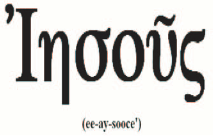 Ι = 10
Ι = 10
Η = 8
Σ – 200
Ο = 70
Υ = 400
Σ = 200
Total = 888
There are many other places in the Bible that show the significance of the number 8. Suffice it to say that indeed the number eight is impressed in Scripture as a sign of superabundance, resurrection, and regeneration.
The Eighth Day: the Post-Millennial Period
This eighth day of the fall Feast gives every indication of picturing the post-millennial age. This rationale is two-fold:
- The day, in time order, follows the seven-day Feast of Tabernacles, which pictures the seven days of the millennial period, seven (shevah) meaning “to be full, satisfied, or have enough of.”
- The day pictures a time of superabundance, resurrection, and regeneration, all of which, as we will see, are typified within the post-millennial period.
- Superabundance because of the Tree of Life being present, as it was in the Garden of Eden, with its magnificent abundance (Revelation 22:2; Genesis 2:8-9)
- Resurrection because of the raising of many people at the Great White Throne Judgment (Revelation 20:11-13)
- Regeneration because this time will be one of a “new heaven and new earth” (Revelation 21:1)
While not much information is given in Scripture about this day, it is possible to put together a logical scenario of what will occur during this time. The following figure gives a time-line of this period, and the period leading up to it. Notice the four major points regarding this post-millennial period.

“And I saw thrones, and they sat on them, and judgment was committed to them. Then I saw the souls of those who had been beheaded for their witness to Jesus and for the word of God, who had not worshiped the beast or his image, and had not received his mark on their foreheads or on their hands. And they lived and reigned with Christ for a thousand years” (Revelation 20:4-6).
1. Once the thousand years are finished Satan will be released from his prison in the bottomless pit (Revelation 20:7). He and his minions will then “… go out to deceive the nations which are in the four corners of the earth, Gog and Magog, to gather them together to battle, whose number is as the sand of the sea” (Revelation 20:8). Then the devil is cast into the lake of fire and is destroyed, as prophesied in Ezekiel 28:18: “… I turned you to ashes upon the earth in the sight of all who saw you.” The finality of Satan is described in the next verse, verse 19: “… and [you] shall be no more forever.” He will be utterly destroyed!
2. After Satan is destroyed — and certainly with him the evil spirits who followed him (Revelation 12:4) — the Scripture states:
“Then I saw a great white throne and Him who sat on it, from whose face the earth and the heaven fled away [pheugo, ‘to run away’]. And there was found no place for them” (Revelation 20:11).
The heaven [ouranos, “atmosphere or sky”] fleeing away is linked to II Peter 3:7, 10-13, which describes a burning of the earth, which in verses 6 and 7 shows this to be a direct parallelism with the great Flood. This proves that the “fire” does not utterly “dissolve” or eliminate the earth’s elements, but rather, like the waters of the Flood, the fire cleanses the earth of its evil. There will be much destruction on the earth after Satan and the evil angels are released after the 1,000 years, and this destruction will be purified by fire rather than water as in the days of Noah.
“But the heavens and the earth which are now preserved by the same word, are reserved for fire until the day of judgment and perdition of ungodly men” (II Peter 3:7).
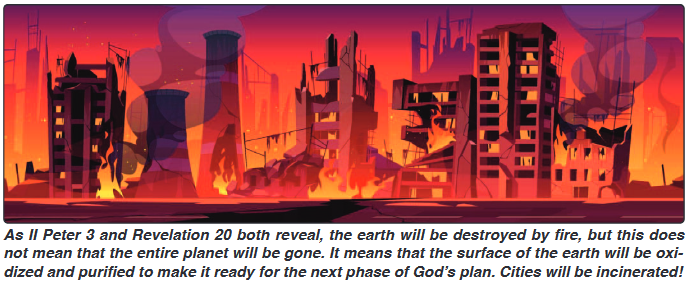
Then Peter writes about the nature of this destruction by fire.
“But the day of the Lord will come as a thief in the night, in which the heavens will pass away with a great noise, and the elements will melt with fervent heat; both the earth and the works will be burned up …. looking for and hastening the coming of the day of God, because of which the heavens will be dissolved being on fire, and the elements will melt with fervent heat?” (II Peter 3:10, 12).
pass away = parerchomai, “to come near or aside, i.e. to approach (arrive), go by (or away).”
elements = stoicheion, “orderly arrangement.”
melt = luo, “to loosen (literally or figuratively).”
feveret heat = kausoo, “to set on fire.”
burned up = katakaio “to burn down (to the ground).”
dissolved = luo (see above).
fire = puroo, “to kindle, to be ignited, to glow (literally), be refined.”
melt = teko, “to liquify.”
Notice that the Greek definitions in II Peter 3 do not indicate the heavens and earth in some way dissolve away and disappear. The earth’s surface “goes away” from its original chaotic condition, the things on the earth are “loosened,” they are “burned down,” and are “ignited” and “liquified,” as it were. These words describe a consumption of things on the earth’s surface and in the atmosphere with intense heat and fire … a purification process. This purification intricates a new eon of the earth’s existence, analagous to the re-creation of the earth’s surface and atmosphere in Genesis 1, and the emergence of a new world after the great Flood. Will there be a re-creation of the earth’s ecosphere at this point? I believe there has to be in order to sustain the population of people that will be raised after this cleansing (Revelation 20:12-13).
Then, after this purification will be the White Throne Judgment.
3. Then John saw “… the dead, small and great, standing before God [at the throne], and books [biblion, ‘a roll’ were opened” (Revelation 20:12). I believe these “books” refer to the physical DNA and human spirit of these resurrected people. See Psalm 139:14-16, where our substance (body) was written in God’s book even before our birth … perhaps even before conception. These are partakers in the second resurrection implied in Revelation 20:5, and I believe it is a physical resurrection of all of mankind who were not called and chosen throughout history. As Revelation 20:12-13 states,
“And I saw the dead, small and great, standing before God, and books were opened. And another book was opened, which is the Book of Life. And the dead were judged according to their works, by the things which were written in the books. The sea gave up the dead who were in them, and Death and Hades delivered up the dead who were in them. And they were judged each one according to his works.”
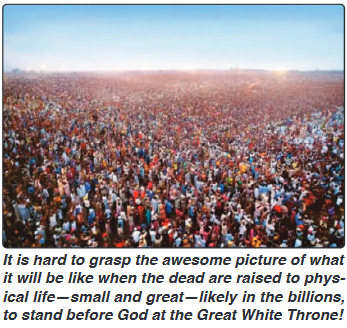 I believe that these countless individuals, each of whom the Eternal loves because they are made in His image, will be given physical life to prosper and grow, raise families and learn the Creator’s plan and the sacrifice of Jesus Christ for their sins. Like us in this age, these people will have to overcome their personal tendencies to sin and the errors of their past lives when they lived in a Satan-deceived world. Satan will no longer be around, but these resurrected beings will need to repent and receive the spirit of God. That includes the countless aborted children and those who died before maturity, whom I believe will be raised as mature adults. Those drowned in the Flood, those who were deceived and followed false teachers, those killed in wars or who succumbed to illness, will be raised and given new life!
I believe that these countless individuals, each of whom the Eternal loves because they are made in His image, will be given physical life to prosper and grow, raise families and learn the Creator’s plan and the sacrifice of Jesus Christ for their sins. Like us in this age, these people will have to overcome their personal tendencies to sin and the errors of their past lives when they lived in a Satan-deceived world. Satan will no longer be around, but these resurrected beings will need to repent and receive the spirit of God. That includes the countless aborted children and those who died before maturity, whom I believe will be raised as mature adults. Those drowned in the Flood, those who were deceived and followed false teachers, those killed in wars or who succumbed to illness, will be raised and given new life!
Notice that people were raised from both the sea (especially those killed in the Flood) and from the land [Hades, or hell = haides, “the grave’]. They were judged [krino, “to distinguish, i.e. decide” ] according to their work, but this cannot possibly mean that they were given eternal life with some sort of sliding scale of more good works giving a better “position” in God’s government. All sin deserves death, and everyone has sinned, so all deserve death. Only through the shed blood of Christ and His calling, granting His spirit with the forgiveness of sins, can a person become one with the Creator. God is no respector of persons, and grants eternal life equally to all of His people regardless of their past sins. There is no hierarchy in His family, only a brotherhood alongside Christ (Romans 8:29). By grace you are saved through faith, which is a gift of God and not earned by works (Ephesians 2:8-9).
I believe that when John wrote the dead were judged according to their works, by the things written in the books (Revelation 10:12, 13), he meant that these individuals would be given responsibilities based on their DNA and human spirit … their talents and gifts. Note Revelation 22:12:
“And behold, I come quickly; and My reward is with Me, to give every man according as his work shall be.”
Other translations agree with this KJV rendition. This same translation should apply to Revelation 20:12 and 13, since God has promised His people responsibilities in His realm: “In My Father’s house are many mansions [mone, residence”]. … I go to prepare a place for you” (John 14:2).
It is possible that the people symbolically raised in the “Valley of Dry Bones” in Ezekiel 37:1-14 are these people who are raised at the beginning of the next eon. Verses 10-12 state:
“So I prophesied as He commanded me, and breath came into them, and they lived, and stood upon their feet, an exceedingly great army. Then He said to me, ‘Son of man, these bones are the whole house of Israel. They indeed say, “Our bones are dry, our hope is lost, and we ourselves are cut off!” Therefore prophesy and say to them, “Thus says the Lord God: Behold, O My people, I will open your graves and cause you to come up from your graves, and bring you into the land of Israel.”‘”
However, this Scripture does not indicate the resurrection to physical life of the gentile nations, most of whom have not been called to the knowledge of the Eternal throughout the last 6,000 years; one would expect them to be mentioned in this Scripture if this applies to the Great White Throne resurrection. when presumably all people from all nations who have not previously been called will then be called and raised. The verses mention only Israel being raised. Thus, this may simply refer to the renewal of the hopes that Israel had lost when they were taken captive and deported to Mesopotamia: “Our bones are dry, our hope is lost, and we ourselves are cut off!” The symbolism of dry bones being Israel’s lost hope is clear.
4. After the White Throne Judgment, John goes on record that he saw “a new heaven and a new earth, for the first heaven and the first earth had passed away” (Revelation 21:1). Then God says, “Behold, I make all things new” (Revelation 21:5). Here is the beginning of a new eon following the millennium. It is a remarkable new world, described vividly in Revelation 21 and 22:
- The Holy City will be present, visible in the physical realm, no longer spirit, and the Father will be with His people (Revelation 21:2-3).
- There will be no death, sorrow, crying, or pain; His people will be comforted (Revelation 21:4).
- Jesus and the Father will be the temple of the Holy City, which will give light day and night (Revelation 21:23-24).
- The ecosphere of this new world will be incredible, like the heavenly realm is today, typified by the tree of life with it twelve fruits (Revelation 22:2).
- There will be people and nations at this time, and they will walk in the light of the Father and Christ (Revelation 21:23, 26).
- The New Jerusalem will be an incredible spectacle, comprised of gemstones, gold, and glowing with light (Revelation 21:10-23).
- Only those who are written in the Lamb’s Book of Life will enter the city (Revelation 21:27).
- A pure river of living water, crystal clear, will proceed from the throne of the Father and Christ, and Trees of Life will grow along the river, yielding twelve fruits, one for each month of the year; the leaves will heal the nations (Revelation 22:1-2).
- Only commandment keepers will eat of the tree of life or enter into the city (Revelation 22:14).
The Post-Millennial Eon
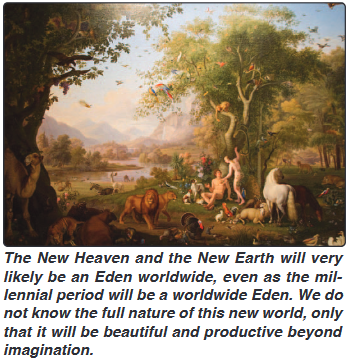 We have seen how wonderful the restored earth will be with the deposing of Satan and his allies, the resurrection to physical life of those people not previously called, and the manifesting of the awesome New Jerusalem with its self-generating light from the Father and Christ. Might the resurrected saints also add to that light?
We have seen how wonderful the restored earth will be with the deposing of Satan and his allies, the resurrection to physical life of those people not previously called, and the manifesting of the awesome New Jerusalem with its self-generating light from the Father and Christ. Might the resurrected saints also add to that light?
It is impossible to spell out all aspects of this renewed eon, and many questions remain. What will be the future of these resurrected people to physical life? Will they raise families as in today’s age? When will they be resurrected to eternal life as those had been in the first resurrection? What about those people who will not be allowed to enter the Holy City due to their lawlessness (Revelation 21:27; 22:15)?
Will there thus be people living on earth at this time who are “… dogs and sorcerers and sexually immoral and murderers and idolaters, and whoever loves and practices a lie “ (Revelation 22:15), or “anything that defiles, or causes an abomination or a lie” (Revelation 21:27)? The fact that these evil people are mentioned seems to indicate there will be evil existing in the new age.
Perhaps we should heed the wisdom of Solomon in Ecclesiastes 1:9-11:
“So I became great and excelled more than all who were before me in Jerusalem. Also my wisdom remained with me. Whatever my eyes desired I did not keep from them. I did not withhold my heart from any pleasure, for my heart rejoiced in all my labor; and this was my reward from all my labor. Then I looked on all the works that my hands had done and on the labor in which I had toiled; and indeed all was vanity and grasping for the wind. There was no profit under the sun.”
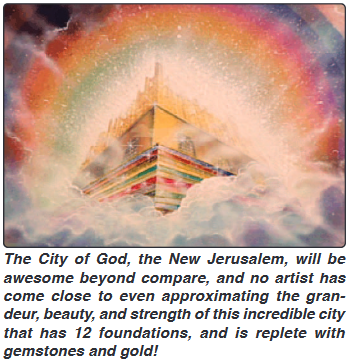 That which has been done is what will be done. What was in ancient times is what will be in future times. Will the eon beyond the millennium be similar to the millennial age or even the present age, with variations? Will that eon be like the Garden of Eden period, when our first parents live with the perfect environment for human existence? We do not know many details about that Garden, but it could have actually been the Holy City where Adam was placed, and where Satan met him and Eve. After all, we read in Ezekiel 28:13 that Lucifer — who later became Satan — was in Eden, the garden of God. I believe that garden of God is the Holy City, which Lucifer was cast out of after he sinned after he had tried to exalt his throne above the stars (spirits) of God (Isaiah 14:13).
That which has been done is what will be done. What was in ancient times is what will be in future times. Will the eon beyond the millennium be similar to the millennial age or even the present age, with variations? Will that eon be like the Garden of Eden period, when our first parents live with the perfect environment for human existence? We do not know many details about that Garden, but it could have actually been the Holy City where Adam was placed, and where Satan met him and Eve. After all, we read in Ezekiel 28:13 that Lucifer — who later became Satan — was in Eden, the garden of God. I believe that garden of God is the Holy City, which Lucifer was cast out of after he sinned after he had tried to exalt his throne above the stars (spirits) of God (Isaiah 14:13).
Whatever your view is of the post-millennial world, may this paper help guide you into deeper understandings of that magnificent age to come. These future events are guaranteed to be much greater than any of us have dreamed about, for as the words of Paul state:
“However, we speak wisdom among those who are mature, yet not the wisdom of this age … but we speak the wisdom of God in a mystery, the hidden wisdom which God ordained before the ages for our glory …. But as it is written:
‘Eye has not seen, nor ear heard,
Nor have entered into the heart of man
The things which God has prepared for those who love Him’” (I Corinthians 2:6-7, 9).
By grasping even a bit of the reality of the Last Great Day we can move forward each day into the reality of Jesus Christ’s words, spoken by Him on “… that last day, that great day of the Feast:”
“If anyone thirsts, let him come to Me and drink. He who believes in Me, as the Scripture has said, out of his heart will flow rivers of living water” (John 7:37-38).
May that living water through His spirit in you pour out of your heart, and nourish and cleanse every part of your life while you await the coming of the millennial age, and that incredibly wonderful age beyond it!

